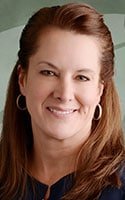In her 10th year as CEO, Kate Rolf talks about the mission, challenges facing Nascentia Health and how she sees the future of the nonprofit
By Mary Beth Roach

Kate Rolf is in her 10th year and the top leader of Nascentia Health Inc. The nonprofit brings together the services and programs of the Visiting Nurse Association of Central New York, Inc., CCH Home Care & Palliative Services, Inc. and Independent Health Care Services, Inc.
The agency, based in Syracuse, has a budget of $325 million and about 550 employees over a large portion of the state. She provides an overview of the agency, especially the work it has been doing during the COVID-19 pandemic, assisting with the testing and most recently, the vaccination processes.
Q: What services does Nascentia Health offer?
A: We offer our certified home health agency, which is skilled nursing care for those who need assistance at home — chronic disease management; rehab, such as occupational and physical therapy; wound care; post-surgery care, palliative care, pediatric and maternal child care. We have home aides, like the licensed home care services, providing personal care, meal preparation, light housekeeping, running errands, picking up prescriptions, medication reminders, those types of services, where you have an aide helping you out in the home. Then we have our insurance plans, which are our managed long-term care plan, which delivers long-term care services, like a nursing home without walls concept, where we’re coordinating all the care and services to keep chronically ill or disabled in the home by providing the care, and supports and services in the home. Then we have the Medicare and Medicaid Advantage plans.
Q: How big is Nascentia’s coverage area in Central New York?
A: We are in 48 counties for our managed long-term care plan. For our Medicare Advantage plan, we are in eight counties — Albany, Broome, Columbia, Delaware, Erie, Niagara, Greene and Onondaga. For our home health and our certified and our licensed home care agencies — our VNA and Home Aides — we’re in five Upstate counties that are Onondaga, Cayuga, Oneida, Oswego and Jefferson counties. Our Medicare plans have an average census of about 3,800 patients. Our home health agency, we have around 900 patients. It’s down a little bit because of COVID.
Q: How is Nascentia funded?
A: Our revenue comes mainly from Medicaid, Medicare and commercial insurances.
Q: How has COVID-19 affected the delivery of your services, and how has Nascentia met those challenges?
A: Nascentia Health partnered with Onondaga County to ensure access to critical front-line nursing resources and to assist in implementing measures to prevent and slow the spread of COVID-19. Nascentia nurses were sent into senior living facilities across Onondaga and Madison counties to provide testing, and then further expanded its efforts through staffing walk-in and drive-thru testing sites in the counties. Initially, as everyone was still learning more each day, Nascentia just focused on being there to provide staff and educational services to the community, as well as anything else needed. As the needs changed, so did Nascentia, including opening a weekend testing clinic at its Syracuse office during the height of cases in the winter months and now on to providing in home vaccinations for home bound individuals unable to get to vaccination site.
Q: The people that you’re vaccinating are they your clients, or how is it determined who you vaccinate?
A: Starting this week, we’re doing about 500 a week, based on how many vaccines we get. Starting with our patients and then working on who we have in our managed long-term plan as well any referrals from local hospitals or physician offices – anyone that they would have that are in need.
Q: How do you see Nascentia growing in the future?
A: We want to continue to make it as easy as possible for patients to receive the care they need where they want it most — at home. And especially post-pandemic, how can we really look at ways to keep people at home? If ever there were something to come up like this again, what can we do to expand our program that keeps people out of nursing homes? We’ve also developed an Article 28 clinic, which is a medical clinic, working to provide more in-home visits so that we can allow for more in-home direct patient care, along with our medical plans, so patients can have a nurse practitioner and doctor visits right in their home. We’re trying to find some new ways, even beyond telehealth, to get them the care that they need.
Q: With your experience in this field, why is it important for people to stay in their homes as opposed to a nursing home?
A: Nursing homes are very important. But there’s also a lot of opportunity for people to stay at home. If we can remove some of the barriers so it is easier for people to stay at home, let’s do that. Let’s make it as feasible as possible to stay at home because we know if we’re not congregating people, we’re eliminating one more issue for any future pandemic. People are happier to be in their home environment.
Q: What are the most rewarding aspects of your job?
A: We have our clinical staff submit some of the stories of the people we help. I like to bring that to our board members, so we can hear some of the wonderful things that we’ve done for people, some of the recovery stories, some of the wonderful, touching things that have happened. Knowing you’ve made a difference in someone’s life, and made something happen, it makes me feel like we’re accomplishing what we set out to do.

